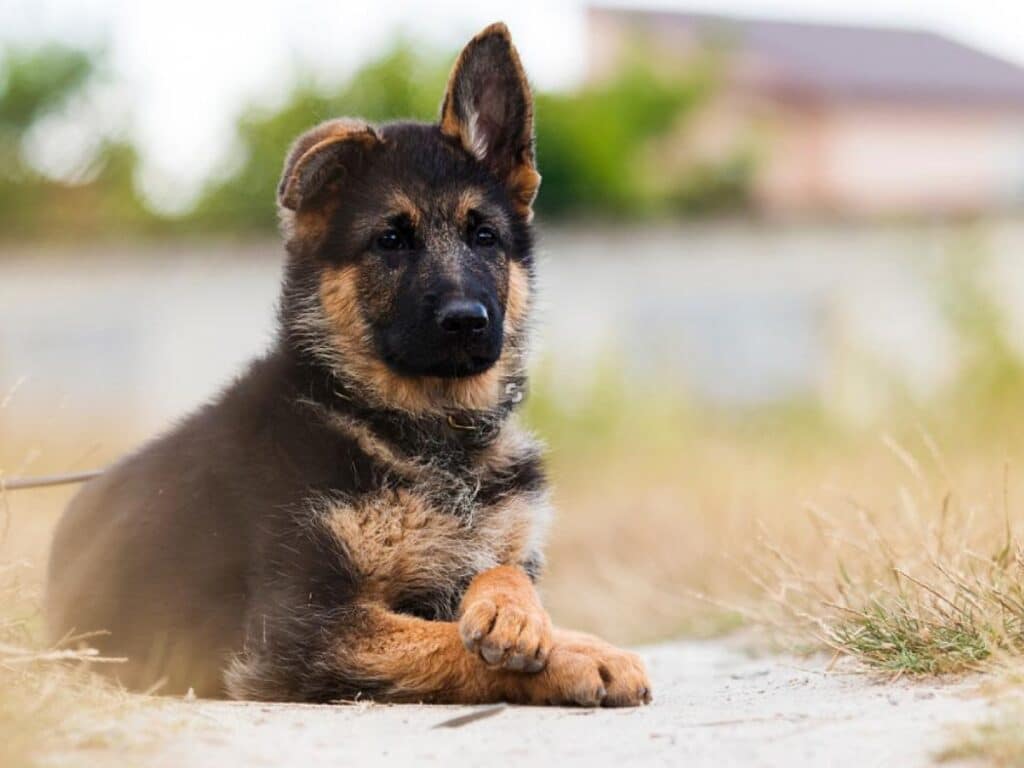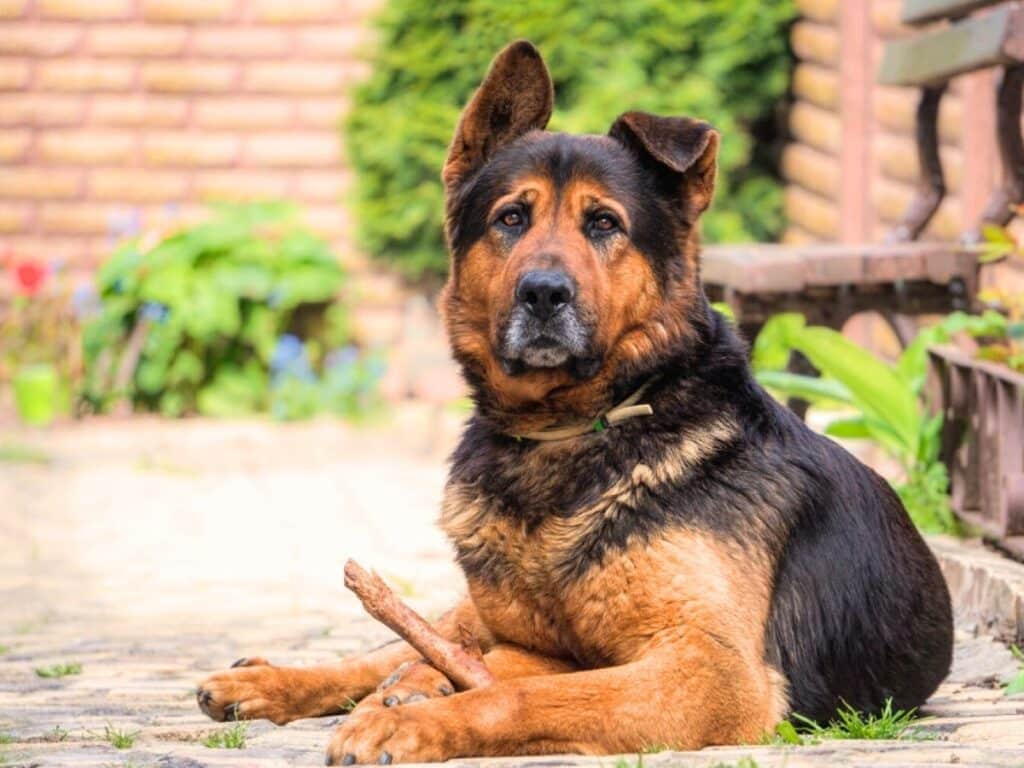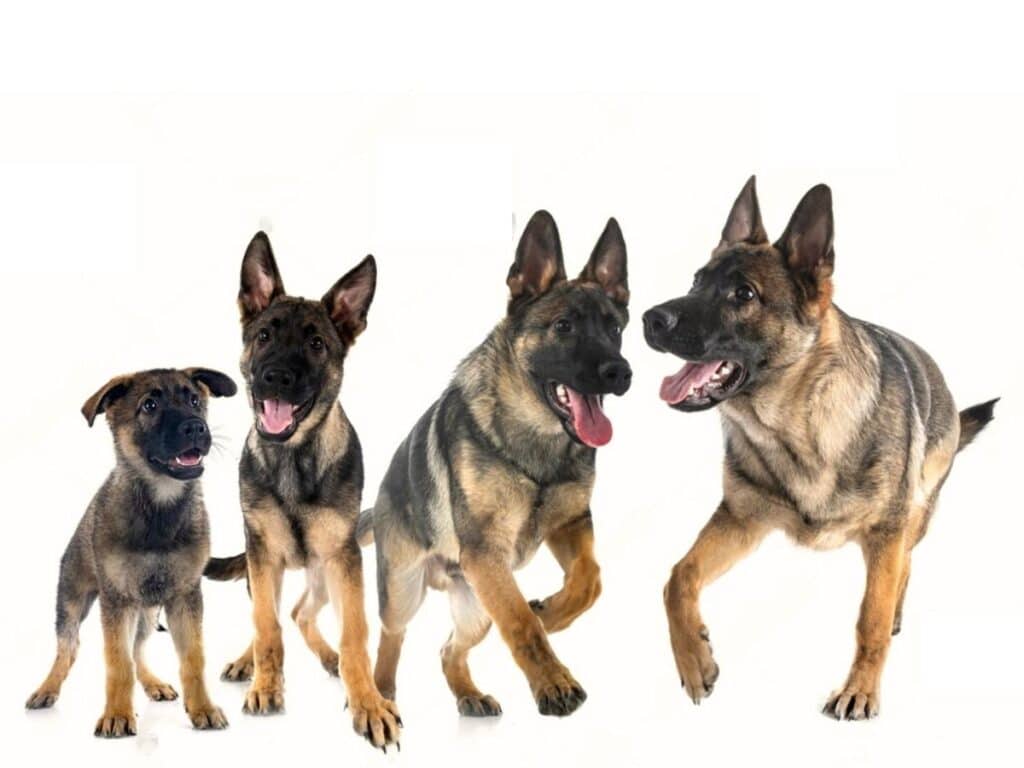Do you have a floppy-eared German Shepherd? Do they cause embarrassment and frustration?
Here is some good news. We’ve got a few simple solutions to fix your German Shepherd’s floppy ears.
They will help get your pup’s ears back up in no jiffy. Keep on reading and restore your beloved pup’s pride!
Key Takeaways:
- The ears of your German Shepherd puppy usually begin to stand up at around 5 months of age, although it can take up to 8 or 9 months for some puppies.
- It is completely normal & safe if your dog’s ears do not both stand up, and it is not uncommon for German Shepherds to have one ear up and one ear down.
- Floppy ears in German Shepherds can be attributed to various factors, including genetics, breeder decisions, inadequate nutrition, or accidental damage.
- You can assist in correcting your German Shepherd’s floppy ears through proper nutrition, providing suitable chewing toys to strengthen the jaw and ear muscles, and utilizing taping methods to encourage upright positioning.
Why Does My German Shepherd Have Floppy Ears?

German Shepherd dogs are known for their pointy, erect ears, but some may have floppy ears.
The reason for this is due to genetics.
Certain genes control the development of cartilage, which is responsible for the shape of the ears.
If a German Shepherd inherits the recessive gene for floppy ears from both parents, it will have floppy ears.
On the other hand, if it inherits the dominant gene for erect ears, its ears will stand up.
To fix floppy ears in German Shepherds, there are three main options.
The first option is to tape the ears with a breathable material to hold them in an upright position, usually done with younger puppies.
The second option is using splints or braces to support the ear and encourage it to stand up.
This method is typically used on puppies whose ears have not fully developed yet.
And, the third option is surgery, also known as otoplasty. This involves cutting and stitching the ear to make it stand upright.
We will be discussing methods to fix your pup’s floppy ears in a lot more detail, later in the article.
It is important to note that floppy ears do not affect the health or behavior of a German Shepherd.
However, some breed standards require erect ears, so it may affect the dog’s eligibility for showing.
When Do A German Shepherds Ears Stand Up?

The ears stand up when the cartilage in the ears has become strong enough to hold them upright.
Different puppies may have different timelines for their ears standing up. Additionally, the breed of German Shepherd can also influence the timing.
RELATED: When Do German Shepherd Ears Stand Up?
Ear Standing Timeframe
German Shepherd puppies’ ears typically start to stand up when they are around 5 months or 20 weeks old.
Generally, by the time they are 5 – 6 months old, their ears will be fully upright. However, several factors influence the timeline.
Some German Shepherd puppies take a little longer for their ears to stand up than others.
Sometimes, it might take up to 6 – 8 months, while in some cases, it happens within just a few weeks.
The ear standing timeframe also depends on environmental factors such as diet, exercise quality and other elements that have an impact on a dog’s growth.
It is essential to note that not all German Shepherds end up with erect or pricked ears; some may end up with floppy ears due to genetics or medical ailments like infections or skin problems.
If your German Shepherd has floppy ears even after their 5th month, there may be ways of aiding them to stand upright.
One way is using adhesive tape techniques which are best administered by a professional dog handler in order not to harm your dog’s ear canal or skin.
But I will teach you this method later in the article so that you can do it yourself at home with only a few easily available items.
RELATED: German Shepherd Puppy Ear Stages
Is It a Problem If Your German Shepherd’s Ears Never Stand Up?

No, it does not matter if your German Shepherd’s ears never stand up naturally.
The appearance of a German Shepherd’s ears can vary from dog to dog, and it is not necessarily an indicator of any health issues or problems.
While the breed standard for German Shepherds often includes upright ears, some German Shepherds have ears that remain floppy or partially upright throughout their lives.
It’s important to note that the ears of German Shepherd puppies typically go through a developmental stage where they may flop or be inconsistent in their positioning.
As the puppy grows, the cartilage in the ears strengthens, and the ears may become fully upright. However, this is not always the case for every individual dog.
If your German Shepherd’s ears do not stand up naturally, it does not affect their overall health or ability to function as a pet.
It is purely a cosmetic characteristic and does not impact their temperament, intelligence, or physical abilities.
Many people find floppy ears endearing and unique, adding to the individuality of their dog.
If you are concerned about your German Shepherd’s ears, or if they were previously erect and suddenly become floppy, it’s always a good idea to consult with a veterinarian.
They can assess your dog’s ears and provide any necessary guidance or advice.
Why Does It Take So Long For A German Shepherd’s Ears To Stand Up On Their Own?

German Shepherd puppies take longer for their ears to stand up on their own compared to other breeds.
This is because the ear cartilage needs time to develop and strengthen. The process can be influenced by genetics, diet, environment, and physical activity.
Here
Additionally, floppy-eared German Shepherds are not recognized as the breed standard, and some breeders intentionally breed them for personal preferences.
As the ear cartilage strengthens, owners can help speed up the process by massaging the ears, providing a nutrient-rich diet, and minimizing head scratching and shaking.
If the ears still fail to stand up after six months, a veterinarian should be consulted to ensure there are no underlying health issues.
Remember, every dog is unique, and the number of weeks or months it takes for their ears to stand up can vary.
It is important to be patient and provide the necessary care for your German Shepherd puppy’s ears.
Why Does My German Shepherd Only Have One Ear Up?

This is only because your German Shepherd’s ears are still in the early stages of development.
During the early stages of a German Shepherd’s life, the cartilage in the ears is soft and malleable.
It gradually begins to firm up and strengthen, allowing the ears to stand upright.
However, if one ear experiences slower or incomplete cartilage development, it may remain floppy while the other ear progresses as expected.
It’s important to note that having one floppy ear and one upright ear is not typically a cause for concern.
As long as the ears are healthy, free from infection or discomfort, and the dog’s overall well-being is not affected, there is usually no need for intervention.
However, if you have concerns about your German Shepherd’s ear development or if the asymmetry is accompanied by other signs of discomfort or health issues, it is advisable to consult with a veterinarian.
Possible Reasons for Floppy Ears In Your German Shepherd
German shepherds are known for their erect and pointy ears, but sometimes they have floppy ears instead. The reasons behind this phenomenon can be linked to a few factors such as:
1. Genetics
The Science Behind the Floppy Ears of a German Shepherd
The drooping ears on a German Shepherd are due to genetic variations passed down from their ancestors.
Genetics plays a significant role in determining the physical traits of a dog, including ear shape and structure.
Some German Shepherds may inherit genes that result in weaker cartilage or ears that don’t naturally stand up.
It’s important to remember that genetics alone can be the primary reason for floppy ears, even when other factors are not present.
2. Inadequate Nutrition
Malnourished puppies are more prone to floppy ears as their cartilage fails to develop correctly, leading to weak ear support.
To prevent such circumstances, pet owners must ensure adequate nourishment with appropriate amounts of proteins, carbohydrates, vitamins and minerals for healthy bone and tissue development.
3. Not Cleaning Your Dog’s Ears Regularly
Regular ear cleaning is essential to maintain good ear health in dogs.
Neglecting proper ear cleaning practices can lead to ear infections, inflammation, or excessive wax buildup.
Prolonged ear infections can cause damage to the ear canal and cartilage, which might contribute to floppy ears.
Furthermore, a regular cleaning with gentle solutions like saline water or vinegar diluted in water ensures your pup’s ears remain free from dirt and wax.
RELATED: German Shepherd Ear Mites Symptoms
4. Ear Injuries

Trauma or physical damage to a German Shepherd’s ears can affect the development and positioning of their ears.
Injuries, such as bites or accidents involving the ears, can harm the cartilage and prevent it from forming the necessary strength to hold the ears upright.
To keep your pup’s ears safe, be mindful of activities or situations that could potentially harm your German Shepherd’s ears.
Avoid allowing them to engage in rough play with other dogs that may lead to ear injuries.
Additionally, take precautions to prevent accidents or trauma to the ears, such as keeping them away from sharp objects or ensuring they are secure during car rides.
But most importantly, DO NOT twist or pull their ears while playing. I know from my own personal experience that it’s very tempting, but it should be avoided.
5. Breeding
Selective breeding practices can influence the likelihood of certain traits being passed down to offspring.
Breeders often aim to produce German Shepherds with desirable characteristics, including erect ears.
However, if breeding pairs both carry genes for floppy ears, there is a higher chance that the puppies will also have floppy ears.
Breeding decisions can impact the frequency of floppy ears within a particular lineage.
How To Fix A German Shepherds Floppy Ears With Tape

To support your German Shepherd’s ears, you might consider taping or wrapping them.
Don’t use regular tapes that you have around your house or they will tear and rip your dog’s tender skin.
Taping German Shepherd Ears
Here’s what you’ll need:
- Large spongy perm rollers (remove the plastic part)
- A porous tape such as 3M Micropore tape
- Sanitized popsicle sticks
Below is the step-by-step guide on how to tape a Floppy-Eared German Shepherds Ears Upright effectively:
1. Wrap your dog’s ears with the tape
Gently clean the inside of the ear.
Wrap the ear around the foam and tape them into a tight roll. In a vertical position. Make sure to smoothen any folds in the ears while you do this.
The roller foam only needs to sit inside the ear enough to support cartilage growth. So make sure you don’t place the foam too deep in the dog’s ears.
Do the same with the other ear.
2. Making a Popsicle Bridge Between the Ears
Take a popsicle stick and attach it to the top part of both ears. In a horizontal position.
This is to make a bridge between your dog’s two ears to help align and support them together, ensuring uniformity.
Be very careful while using he popsicle and tapes and make sure you’re not unintentionally hurting your puppy.
To ensure your furry friend doesn’t lose their hearing ability, you mustn’t cover up their ears entirely with any tapes.
Your puppy’s ears may need up to two weeks to remain standing in the upright position. During this time, your puppy will probably manage to remove the popsicle stick and might even start unraveling the tape from his ears.
3. Checking and Removing Ear Taping Weekly
To maintain the progress of your German Shepherd’s ear standing, you need to check and remove its ear taping weekly. To do this, follow these easy steps:
- Gently remove the tape around your dog’s ears.
- Check for any signs of irritation or redness on the skin around the ears.
- Examine the ears to ensure that they are still in an upright position.
- Clean their ears with a cotton swab and an ear solution carefully.
- Reapply new medical-grade tape across the base of your dog’s ears, again making sure it’s not too tight nor too loose.
- Lastly, reward your furry friend with positive reinforcement for being cooperative and patient throughout the process of removing and retaping.
While you’re checking and removing ear taping weekly, watch out for any scars that may be appearing from previous tape applications.
If you detect any creases or deformities in the outer part of their ears, don’t panic as it happens due to a lack of consistent effort. Keep checking regularly.
Is Taping Floppy Ears of a German Shpeherd Bad for Them?
Taping a German Shepherd’s ears, when done correctly is generally not harmful to the dog.
However, it is important to note that improper taping techniques or using inappropriate materials can potentially cause discomfort, pain, or injury to the dog’s ears.
Use Appropriate Materials
The materials used for taping should be safe, clean, and designed specifically for dog ear taping.
Using improper materials, such as adhesive tape or items not intended for this purpose, can lead to skin irritation, sores, or damage to the ears.
Monitor for Discomfort or Complications
Regularly check your German Shepherd’s ears for signs of discomfort, redness, swelling, or any adverse reactions to the taping. If you notice any issues, consult with a professional promptly to address them.
Remember that ear taping is typically done for a specific period of 14 days. Prolonged or unnecessary taping can potentially cause problems or restrict the natural development of the ears.
Surgical Ear Implants – The Last Resort
When all other methods to fix a floppy-eared German Shepherd fail, surgical ear implants can be a viable last resort.
This procedure involves the insertion of implants under the skin of the ears to provide support.
However, it is crucial to consult with a qualified veterinarian before deciding on this option, considering the cost and potential risks associated with surgery.
While this method may seem like an easy fix, surgical ear implants do not always guarantee success and are generally not recommended unless all other options have been explored.
The healing process after surgery is typically slow and requires strict adherence to post-operative care guidelines to prevent any complications or infections.
An essential consideration is that this surgery can come at a considerable financial cost, and there’s no assurance that it will work permanently.
Additionally, surgical ear implants may lead to scarring or nerve damage if done wrong.
It is worth seeking advice from experts in the field of dog breeding and training before attempting any corrective measures for your German Shepherd’s floppy ears.
Natural Ways To Get Your German Shepherds Ears To Stand Up
German Shepherds Ears: 5-step guide to making them stand up naturally!
Looking for ways to help your German shepherd’s floppy ears stand up? Here are five easy steps to follow:
- Start early: Begin training your puppy as soon as possible as it’s harder to get adult dog ears to stand up.
- Provide proper nutrition: Feed your pup with a balanced diet with sufficient nutrients like protein, vitamins, and minerals.
- Exercise regularly: Regular physical activity promotes good health and helps to strengthen ear cartilage.
- Use a dental chew toy: Chewing on hard toys promote jaw strength and can help strengthen muscles that support the ears.
- Seek professional help: In extreme cases, surgical procedures like ear taping or ear cropping may be necessary. Consult a professional vet for more information.
Proper Nutrition
The right choice of nutrition for your German Shepherd can make a significant difference in their ear health and standing. The nutrient balance directly affects the growth and development of cartilage, which supports the ear structure.
Providing a high-quality protein diet that includes chicken meal, fish oil or salmon provides the necessary amino acids and vitamins essential for cartilage creation.
Additionally, incorporating omega-3 fatty acids help in reducing inflammation and promote immune function.
A low-quality kibble lacks the required amount of nutrients– leading to deficiencies affecting the overall development of your dog’s bone density, body mass index (BMI)and worst – causing them anemia, thus disrupting hair growth also leading to droopy ears.
Don’t go for only meat-based diets rather focus on providing balance.
A blend of fruits and vegetables like sweet potatoes and strawberries ensures Vitamin C – an essential component- facilitating fiber intake to ease bowel movement keeping your furball healthy at all stages of life.
Providing Proper Chew Toys
German Shepherds love to chew, and providing them with the right kind of toys is essential.
Appropriate Chew Toys can help promote healthy teeth growth and prevent your dog from chewing on inappropriate objects.
– Chew Toys made of Rubber are perfect for your German Shepherd as they help exercise their jaw muscles
– Rope and Tug Toys can be a great option for helping strengthen their jaw muscles
– Puzzle Toys are another excellent choice that keeps your dog mentally stimulated, which can be just as important as physical exercise
– Rawhides or Bully Sticks can also be given during supervised playtime as they satisfy their need to chew.
Toys should always match the chewing style and activity level of your pet.
Never give very hard toys which could damage teeth or toys that could obstruct breathing.
Playing and Disciplining Them Properly
To train your German Shepherd effectively, understanding the proper ways to play and discipline them is key.
Playing with toys that stimulate their mental capacity and allowing plenty of exercise can keep them obedient.
Using positive reinforcement methods like treats and affection encourages good behavior over punishment.
Providing structure in their daily routine with regular feeding times and designated areas to rest increases loyalty and attentiveness.
It’s important never to use physical punishments as it can damage trust levels. Instead, substitute challenging behaviors with tasks that appeal to their strong desire for purpose such as obedience classes or assigning them a meaningful job.
True story: Todor “The Professor” Zhivkov of Canada rescued a young German Shepherd from an abusive household where its previous owner had forcibly cut its ears too short causing permanent damage and leaving them unable to stand up straight. Working tirelessly over several months using many of these techniques listed above, The Professor was eventually able to give the dog back a sense of pride by fully standing up his ears once again through fierce dedication and love.
Ear Development in GSD Puppies

The Aural Development Journey in Young Canines
A crucial stage for your puppies’ ears is when they start to stand on their own. A puppy’s ears will normally begin to show signs of perking within weeks; however, this process can be gradual.
German Shepherd puppies are prone to having droopy ears due to soft cartilage. Factors like genetics, breed, diet, and exercise could all play a role in determining the ideal standing position of a puppy’s ears.
It is imperative that you keep in mind that each puppy develops differently, and what works for one may not work for another.
There are several approaches you could take with your puppies’ ears based on your comfort level and the degree of severity of the problem.
Often, external methods such as taping or gluing the ears together gently may help. Other options like propping your puppies head up or taking them for regular walks helps improve circulation which brings strength to the muscles and cartilage in their auditory organs.
The Role of Cartilage and Muscle Strength
The firmness of the cartilage and the strength of the muscles play important roles in the process of GSD puppy ear development.
The stronger the muscles in the ears and around the head, the better able they are to hold up the ear cartilage.
The cartilage in a German Shepherd puppy’s ears is still soft and flexible, making it difficult for them to stand up on their own.
As the puppy grows, so does its cartilage and muscle strength, resulting in erect ears.
One way to strengthen a puppy’s ear muscles is by regularly gently massaging and rubbing their ears.
Some German Shepherd puppies may require additional help to get their ears to stand upright on their own.
Ear braces or tapes can be used to gently coax the cartilage into position until it is strong enough to support itself.
I remember when my friend’s German Shepherd pup had floppy ears well into his ninth month! After trying various techniques without any luck, they resorted to taping his ears up every night before bed – much like ear braces – so that he wouldn’t pull them off himself during playtimes. Finally, after four weeks of consistent application, his ears stood at attention permanently!
Floppy Ears of a German Shepherd Add Charm

Floppy ears, a unique trait of the German Shepherd breed, can add a touch of charm to their appearance. Their endearing droopiness is often associated with friendliness and approachability.
Beyond aesthetics, floppy ears can also help to protect the dog’s inner ear from debris and water. Additionally, they can enhance the dog’s ability to hear low-frequency sounds.
- German Shepherds with floppy ears have an adorable appearance that may attract more people to them.
- Floppy ears make German Shepherds look less intimidating and more friendly.
- They allow for better airflow around the ear canal and can prevent infections.
- Aid in hearing lower frequencies that are important in hunting or search and rescue situations.
- Due to their softness, they’re more comfortable for the dog when resting their head on different surfaces
- Floppy ears require less maintenance than erect ears since they don’t need pricking or taping
Enjoying Your German Shepherd No Matter How Their Ears Turn Out
Maintaining Your Affection for Your German Shepherd Regardless of Ear Shape
It can be disappointing to see your German Shepherd with floppy ears after eagerly anticipating their erect ones.
However, ear shape does not affect your bond with them. As long as you provide proper care, the dog’s health and personality remain by your side.
Having realistic expectations is crucial in appreciating your German Shepherd. While the breed may exhibit distinct characteristics, their physical features vary and often have a unique appearance regardless. Instead of focusing on their defects, celebrate their uniqueness.
Often, floppy ears are an anomaly in otherwise healthy dogs.
Conducting regular health check-ups and providing maximum exposure to activities that directly affect ear muscles is essential in catering to the dog’s specific needs.
While time-taking, corrective surgical procedures are available for those who insist on achieving specific physical standards for their dogs.
5 Well-Known Facts About “Floppy Eared German Shepherds”:
- ✅ “Floppy Eared” German Shepherds are not recognized by the American Kennel Club as a breed standard. (Source: The Happy Puppy Site)
- ✅ Floppy ears in German Shepherds can be caused by a genetic mutation or improper breeding practices. (Source: Animalso)
- ✅ Floppy ears do not affect a German Shepherd’s hearing or temperament. (Source: Daily Dog Stuff)
- ✅ 3 common fixes for floppy ears in German Shepherds are tape, glue, or surgery. (Source: German Shepherd Corner)
- ✅ It is important to consult with a veterinarian or experienced breeder before attempting any fixes for your German Shepherd’s ears. (Source: PetMD)
Conclusion
The floppy-eared German Shepherd presents a unique aesthetic appeal that many dog lovers find endearing. While this trait may deviate from the traditional erect ears seen in the breed, it is important to understand the underlying causes and potential solutions for floppy ears in German Shepherds. Through careful breeding practices, responsible ownership, and appropriate ear care, it is possible to address this issue and achieve a more desired ear carriage.
FAQs
How do I massage my German Shepherd’s ears?
To massage your German Shepherd’s ears, gently rub the base of the ears in circular motions with your fingertips for a few minutes each day. This helps to increase circulation and strengthen the muscles that support the ears.
What kind of nutrition should I give my German Shepherd to support ear development?
It’s important to feed your German Shepherd a high-quality diet that is rich in protein and contains the necessary vitamins and minerals for healthy ear development. Look for dog food that has ingredients like chicken, turkey, salmon, sweet potatoes, and carrots.
Can I use any kind of tape to help my dog’s ears stand up?
No, you should use special veterinary tape that is designed for this purpose. This type of tape is breathable, flexible, and safe for your dog’s skin. Do not use duct tape or any other type of tape that could be harmful to your dog.
How long does it take for my German Shepherd’s ears to stand up?
It can take several weeks to several months for a German Shepherd’s ears to fully stand up. Consistency is key when it comes to using tape to support the ears, and you should continue to massage the ears and provide proper nutrition during this time.
Is it normal for German Shepherd puppies to have floppy ears?
Yes, it is perfectly normal for German Shepherd puppies to have floppy ears during the first few months of life. However, if your puppy’s ears do not begin to stand up by around 6 months of age, you may want to speak with your veterinarian about more intensive measures to help the ears stand up.




